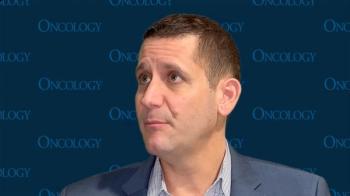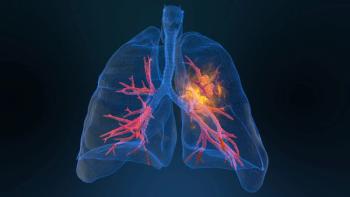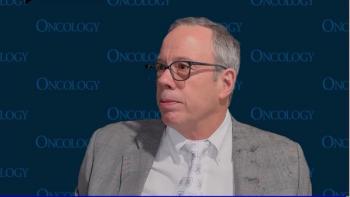
Daratumumab Combo Yields Sustained Benefits in Transplant-Ineligible NDMM
Final analysis data from the phase 3 ALCYONE trial support using frontline daratumumab-containing regimens for those with transplant-ineligible NDMM.
Combining daratumumab (Darzalex) with bortezomib (Velcade), melphalan (Evomela), and prednisone (D-VMP) continued to show clinical benefits among patients with transplant-ineligible newly diagnosed multiple myeloma (NDMM), according to final analysis results from the phase 3 ALCYONE trial (NCT02195479) published in Lancet Oncology.1
After a median follow-up of 86.7 months (IQR, 28.5-85.2), the median overall survival (OS) was 83.0 months (95% CI, 72.5-not estimable [NE]) with D-VMP vs 53.6 months (95% CI, 46.3-60.9) with VMP alone (HR, 0.65; 95% CI, 0.53-0.80; P < .0001). With a threshold of 10–5, minimal residual disease (MRD) negativity occurred in 28% and 7% of patients in each respective arm (OR, 5.23; 95% CI, 3.27-8.36; P < .0001). Data showed that OS improved with D-VMP among patients with MRD-negative status (HR, 0.60; 95% CI, 0.31-1.14) and those without MRD negativity (HR, 0.77; 95% CI, 0.62-0.95).
The median time to subsequent therapy for multiple myeloma was 66.8 months (95% CI, 47.9-NE) in the D-VMP arm and 25.9 months (95% CI, 23.4-28.6) in the VMP arm (HR, 0.37; 95% CI, 0.30-0.46; P < .0001). The most common subsequent antimyeloma treatments in each arm included lenalidomide (Revlimid) plus dexamethasone (14% vs 22%) and carfilzomib (Kyprolis) plus lenalidomide and dexamethasone (5% vs 4%).
Regarding progression-free survival (PFS) events in the next line of therapy, events were highlighted in 53% of the D-VMP arm and 67% of the VMP arm. Additionally, the median PFS in the next line of therapy was 66.7 months (95% CI, 58.6-80.1) vs 42.4 months (95% CI, 37.3-47.1), respectively (HR, 0.56; 95% CI, 0.46-0.68; P < .0001).
“Across the primary, interim, and final analyses of ALCYONE, D-VMP treatment consistently resulted in improved survival outcomes and yielded a higher rate of MRD negativity, with a manageable safety profile. Furthermore, D-VMP was favorable across key subgroups of clinical interest, including older adults and those with higher cytogenetic risk,” lead study author María-Victoria Mateos, MD, PhD, from University Hospital of Salamanca/Instituto de Investigación Biomédica de Salamanca/Cancer Research Center–Institute of Molecular and Cell Biology of Cancer in Spain, wrote with coauthors.1 “With the potential shift towards quadruplet regimens becoming the new standard of care for those with [NDMM], results from ALCYONE and other large clinical trials, such as MAIA [NCT02252172], provide support for the efficacy and use of daratumumab-based regimens in the frontline setting.”
In the international, open-label, multi-center phase 3 ALCYONE trial, 706 patients with transplant-ineligible NDMM were randomly assigned 1:1 to receive D-VMP (n = 350) or VMP alone (n = 356). All patients received subcutaneous bortezomib at 1.3 mg/m2 twice per week on weeks 1, 2, 4, and 5 of the first cycle and once weekly on weeks 1, 2, 4, and 5 of cycles 2 to 9; melphalan orally at 9 mg/m2 once daily on days 1 to 4 of each cycle; and prednisone orally at 60 mg/m2 once daily on days 1 to 4 of each cycle for a maximum of nine 6-week cycles. Those in the D-VMP arm also received daratumumab at 16 mg/kg intravenously once weekly, once every 3 weeks in cycles 2 to 9, and once every 4 weeks afterward.
The trial’s primary end point was PFS, which investigators highlighted in earlier analyses. Secondary end points included OS, depth of response, time to subsequent therapy, PFS on subsequent therapy, and safety.
Patients 18 years or older with NDMM who were not considered candidates for high-dose chemotherapy plus stem cell transplantation due to being 65 years or older or having presence of important comorbidities that may have negatively affected the treatment’s tolerability were eligible for enrollment in the trial.2 Having an ECOG performance status of 0 to 2 was another requirement for study entry.
Across the intent-to-treat population, the median age was 71 years (range, 40-93) and most patients were White (85%). At the time of the final analysis, 78% of patients in the D-VMP arm and 33% of those in the VMP arm had discontinued study treatment, with the most common reasons in each arm including disease progression (48% vs 13%).
At baseline, the mean European Organisation for Research and Treatment of Cancer Quality of Life Questionnaire Core 30 scores for global health status (GHS) were 50.7 in the D-VMP arm and 52.4 in the VMP arm; the respective mean scores were 46.3 and 43.1 for pain and 59.9 and 63.6 for physical functioning. In the D-VMP and VMP arms, respectively, the least square mean of change at 3 months was 7.5 (95% CI, 5.2-9.7) vs 4.0 (95% CI, 1.7-6.3) for GHS, –13.7 (95% CI, –16.5 to –10.9) vs –10.4 (95% CI, –13.3 to –7.5) for pain, and 5.4 (95% CI, 3.1-7.7) vs 4.3 (95% CI, 2.0-6.7) for physical functioning.
Treatment-emergent adverse effects (TEAEs) of any grade occurred in 98% of patients who received D-VMP and 97% of those who were treated with VMP, with the most common toxicities in each arm including neutropenia (51% vs 53%), thrombocytopenia (50% vs 54%), anemia (32% vs 37%), peripheral sensory neuropathy (29% vs 34%), and diarrhea (29% vs 25%). Grade 3/4 toxicities were highlighted in 83% and 77% of patients in each respective arm, with the most common types including neutropenia (40% vs 39%), thrombocytopenia (35% vs 38%), and anemia (18% vs 20%).
Treatment discontinuation due to TEAEs occurred in 9% of patients in the D-VMP arm and 9% of those in the VMP arm. Additionally, 8% and 6% of patients in each respective arm experienced second primary malignancies, with the most common types including basal cell carcinoma (1% vs 1%) and myelodysplastic syndrome (1% vs 1%).
References
- Mateos MV, San-Miguel J, Cavo M, et al. Bortezomib, melphalan, and prednisone with or without daratumumab in transplant-ineligible patients with newly diagnosed multiple myeloma (ALCYONE): final analysis of an open-label, randomised, multicentre, phase 3 trial. Lancet Oncol. Published online April 9, 2025. doi:10.1016/S1470-2045(25)00018-X
- A study of combination of daratumumab and Velcade (bortezomib) melphalan-prednisone (DVMP) compared to Velcade melphalan-prednisone (VMP) in participants with previously untreated multiple myeloma. ClinicalTrials.gov. Updated April 1, 2025. Accessed April 17, 2025. https://tinyurl.com/4m7uaz9j
Newsletter
Stay up to date on recent advances in the multidisciplinary approach to cancer.


















































































